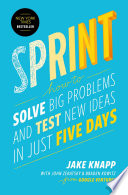

Rapid prototyping is a key component of the Sprint methodology, allowing teams to quickly create tangible representations of their ideas. The goal is to produce a realistic prototype that can be tested with users, even if it is not fully functional. This could be a mockup, a storyboard, or a digital version of the product. The emphasis on prototyping helps teams visualize their concepts and identify potential flaws early in the process. By testing a prototype with real users, teams can gather valuable feedback that informs further development. This iterative approach reduces the risk of investing time and resources into ideas that may not resonate with users, ultimately leading to more successful products.
Continue readingThe Sprint process is a five-day framework designed to solve tough problems and test new ideas quickly. It was developed by Jake Knapp at Google Ventures and is structured to help teams focus on a single challenge. The process is divided into distinct phases: Understand, Sketch, Decide, Prototype, and Test. Each day has specific goals and activities that guide the team through the problem-solving journey. The first day involves gathering insights and understanding the problem from various perspectives. The second day is dedicated to brainstorming and sketching potential solutions. On the third day, the team makes decisions on which ideas to pursue and develops a clear plan. The fourth day is for creating a prototype that embodies the chosen solution. Finally, on the fifth day, the team tests the prototype with real users to gather feedback. This structured yet flexible approach allows teams to iterate quickly and effectively, reducing the time and resources typically required for product development.
Continue readingThe Sprint methodology emphasizes the importance of time constraints in driving innovation. By limiting the process to just five days, teams are encouraged to focus on what truly matters without getting bogged down by unnecessary details or lengthy discussions. This urgency fosters a sense of creativity and collaboration, prompting team members to think outside the box and prioritize essential features. The time constraint also helps prevent 'analysis paralysis,' where teams can become overwhelmed by too many options or prolonged deliberation. Instead, the Sprint process encourages rapid decision-making and prototyping, allowing teams to quickly test their ideas and pivot based on feedback. This approach not only speeds up the development cycle but also cultivates a culture of experimentation and learning within organizations.
Continue readingA core principle of the Sprint methodology is user-centric design, which places the end user at the center of the problem-solving process. Throughout the Sprint, teams are encouraged to keep the user's needs, behaviors, and feedback in mind. This focus on the user helps ensure that the solutions developed are not only innovative but also relevant and valuable to the target audience. During the testing phase, real users interact with the prototype, providing insights that can significantly shape the final product. This user feedback loop is crucial for validating assumptions and refining ideas. By prioritizing user experience, teams can create products that resonate with their audience and address real-world problems effectively.
Continue readingThe Sprint process thrives on collaboration and the inclusion of cross-disciplinary teams. By bringing together individuals with diverse skills and perspectives, teams can approach problems from multiple angles, leading to richer ideas and solutions. Each member contributes their unique expertise, whether it's design, engineering, marketing, or customer service. This collaborative environment fosters open communication and encourages brainstorming, allowing team members to build on each other's ideas. The Sprint methodology also emphasizes the importance of having a facilitator or 'Decider' who can guide the team through the process and make final decisions. This structure not only enhances teamwork but also ensures that all voices are heard, leading to more comprehensive and innovative outcomes.
Continue readingAn essential aspect of the Sprint process is embracing failure as a learning opportunity. Not every idea will succeed, and that is a crucial part of the innovation journey. The Sprint methodology encourages teams to approach testing with an open mind, recognizing that feedback—whether positive or negative—is invaluable. By viewing failures as stepping stones rather than setbacks, teams can iterate on their ideas and improve their solutions. This mindset fosters resilience and adaptability, essential traits for navigating the ever-changing landscape of product development. Moreover, by documenting lessons learned during the Sprint, teams can build a repository of insights that can inform future projects and enhance overall organizational learning.
Continue readingIn the Sprint process, the role of the Decider is pivotal. This individual is responsible for making final decisions on the direction of the project and ensuring that the team stays focused on their goals. The Decider helps to streamline discussions and mitigate conflicts, allowing the team to move forward efficiently. This role is particularly important in a collaborative setting, where differing opinions can lead to indecision. By having a designated Decider, teams can maintain momentum and clarity throughout the Sprint. This structure not only enhances productivity but also empowers team members to contribute their ideas, knowing that their input will be considered in the decision-making process.
Continue reading